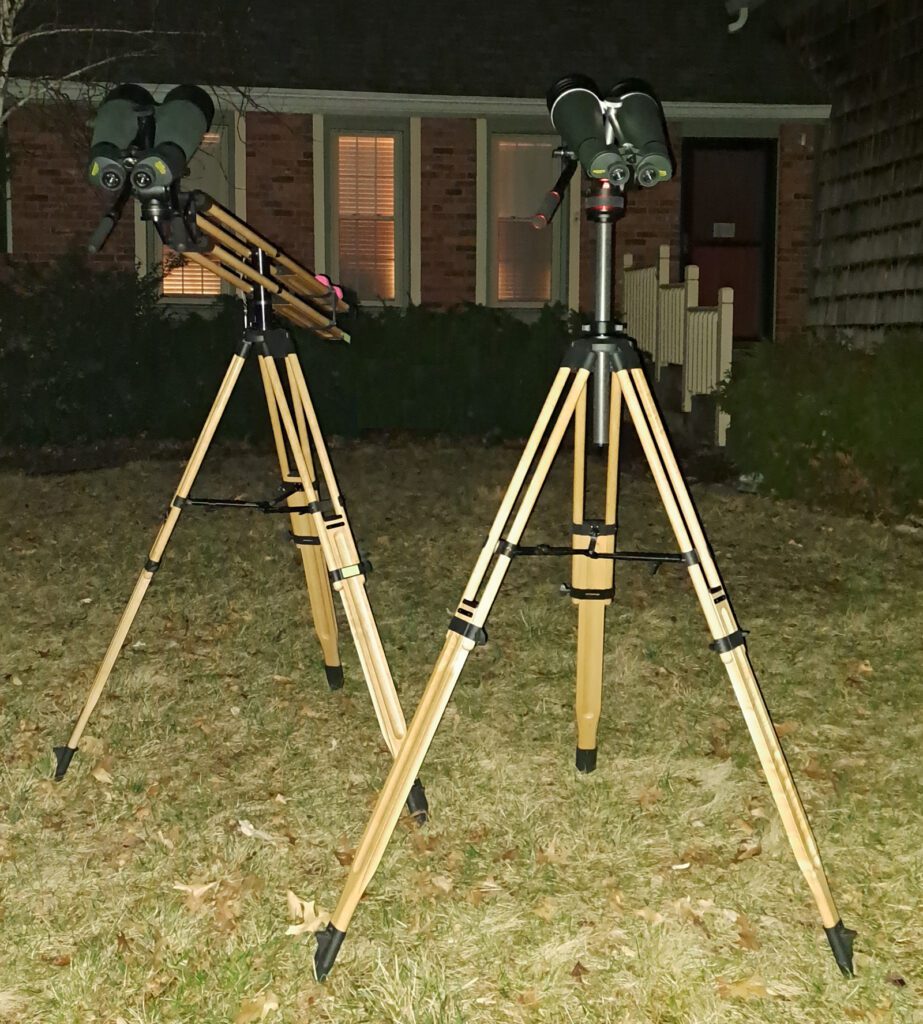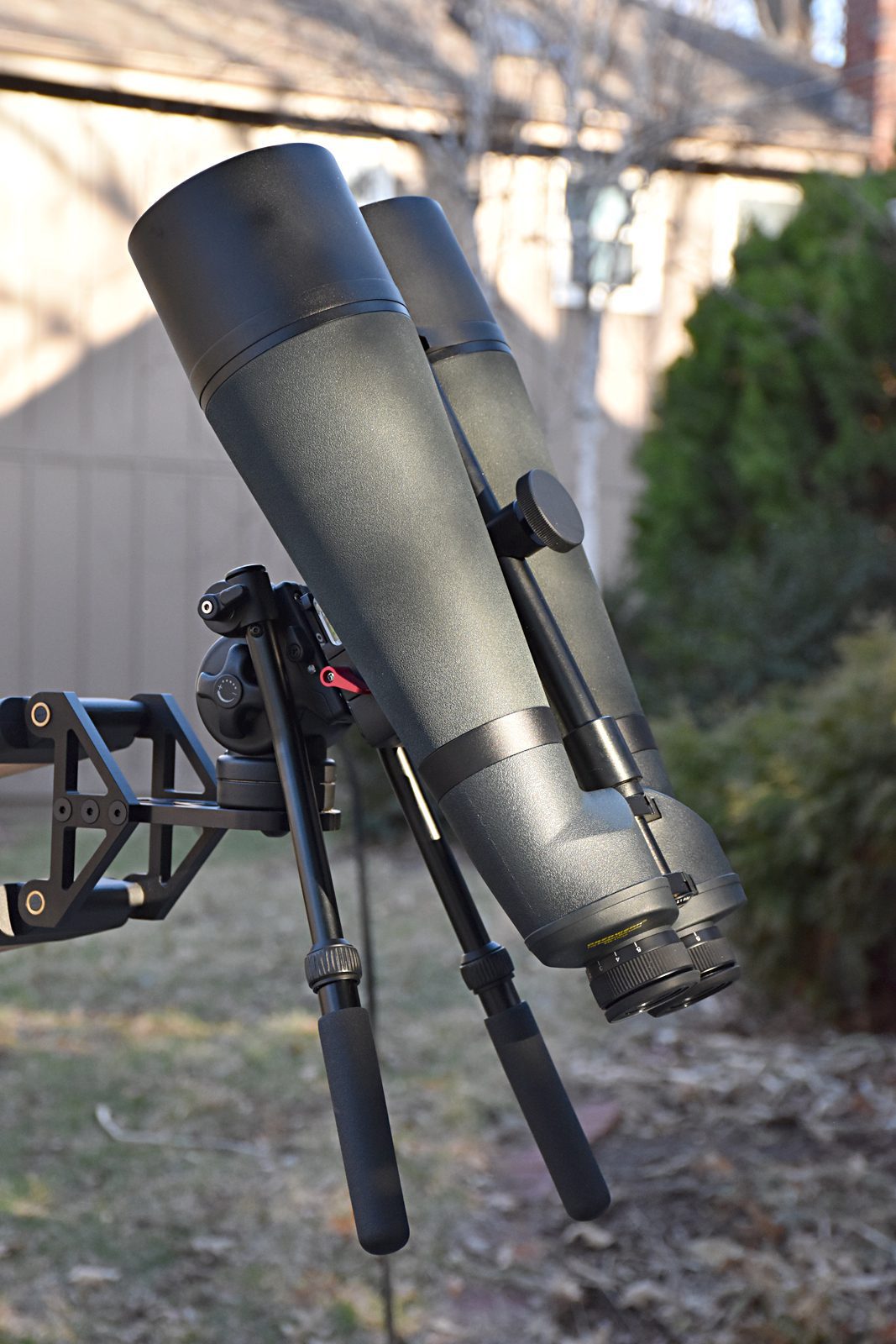It seemed like the forecast for Saturday night (4 March 2023) would not hold up, based on visual satellite imagery, but despite some hazy clouds and a 94.9% illuminated 11-day moon the skies were clear enough to do some observing so both the 25×100 ED Ultra and the 25×100 Deluxe were deployed for an evening of astronomy.

The ED Ultra is shown at left here on an Oberwerk PM2 mount. The Deluxe is on a Farpoint UBM p-gram on an OB 5000 tripod. Make no mistake, 25×100 binoculars are large instruments, weighing over 10 pounds. Heckin’ chonkers as some of my Cloudy Nights friends have declared. If you are planning to purchase one, it’s important to plan for an appropriate mount. To observe with near the zenith with a straight through binocular this large requires a sturdy parallelogram mount. The UBM can barely handle a 25×100 like this. A light touch, finesse, and patience are required to cope with a certain amount of motion, still manageable and pleasing however, and a comfortable observing option because the UBM provides six degrees of motion and can be used from the side, which makes reclining observation possible, allowing the use of a head rest.

The Oberwerk PM2 (shown above and at right mounted on a TR3 tripod) is a much more stable mount. The motions are more intuitive as well, but only four degrees of motion are provided so the mount cannot be used from the side and must be positioned in front of the observer. This prevents it from being used with a zero-gravity chair or things like the cheap green camp chair being used with the UBM.
It occurred to me the following day that if an observing seat (like the Starbound Observing chair) had a wheeled base, it would be easier to position under a p-gram, so I found a wheeled dolly in my garage and the Celestial Boogie Board was born. Honestly, it was more of a lark than anything, but a brief trial Sunday evening showed it to be a surprisingly effective and enjoyable enhancement, so refinements are underway for a more workable long-term solution.
So onto the side by side comparisons.
I started off with observations of the 11-day waxing gibbous moon, nearly 94% illuminated. CA is present around the limb of the moon with both binoculars, but is noticeably more controlled with the ED Ultra. The Deluxe does a respectable job controlling CA, given that it’s an achromat. With careful focusing and positioning, it can be minimized and is not distracting if you can tolerate a small amount of false color. I found the views of the moon with the Deluxe to be enjoyable. The ED Ultra shows noticeably less CA, but a thin line is still present around the limb. Focusing and positioning to minimize/eliminate requires less effort. The same applies to the brightest stars, which have a minor purplish aura with the Deluxe (that I frankly don’t mind and even find somewhat entertaining). It’s not seen on stars fainter than 3rd magnitude, and is more apparent on really bright stars like Sirius (which I used for the comparison). The ED Ultra showed a minor trace of it, but only a CA purist would complain. Sure, if you’ve spent $3300 on a Swarovski 10×50 EL (or even more on a Nikon WX) any hint of CA on bright stars would be a grievance. Otherwise, best get over it and get on with your binocular astronomy life. (Or, shell out for an -SD binocular telescope and premium eyepieces.)
Aside from CA, the two instruments were relatively close on lunar details, the ED Ultra having a slight edge in sharpness and brightness but the difference is extremely subtle.
Oh. Both the ED Ultra and the Deluxe are surprisingly good at minimizing ghosting, even observing a nearly full moon. They both exhibit considerable veiling glare, though I suspect this could be reduced by adding light shield extensions which at any rate are a good way to increase image contrast in light polluted environments.
Here is an image from later when I was making observations in Canis Major and Puppis, the Deluxe is on a TR3 tripod with an NT608 head, at right in this image. I was viewing objects nowhere near the zenith. Using a binocular as large as a 25×100 on a standard tripod is nearly unworkable for observing close to the zenith, honestly. The instruments are too heavy and large to tilt the tripod back for a better angle (which can be done successfully with small, light instruments). I’m perfectly comfortable observing with 45-degree angled BTs, and observing higher in the sky with straight through binoculars, but to comfortably observe at the zenith with instruments like this, there is not a good alternative to a p-gram design.

For deep sky the ED Ultra has a noticeable edge. Viewing the open cluster M41 in Canis Major, the ED Ultra had better contrast, sharpness, and brightness. The difference between the two instruments is not dramatic, but it is definitely there. If it weren’t for comparing the two side by side, one wouldn’t say the Deluxe view is wanting in brightness, sharpness, or contrast. It’s somewhat akin to a 10×42 versus a 10×50 view — the 10×42 seems fine until it’s compared side by side with a 10×50, in which the extra vividness/sparkle is undeniable. The difference in the deep sky view was actually more than I had anticipated. I’ll be doing further side by side comparisons over time. The sky was not great — a nearly full moon with hazy from thin clouds. It might be that on a moonless night with better transparency the difference would be less apparent. I’m curious to explore that.
Both instruments exhibit field curvature, to me well-controlled and unobjectionable. If there is a difference between the two it is incremental. I’ll revisit that characteristic in subsequent observing sessions to arrive at a more definite assessment. At this point, I would hesitate to say that the ED Ultra edge performance is better than that of the Deluxe. If it is better, the difference is subtle. If you worry about edge performance, best save your money for a BT and premium eyepieces — the Pentax 10mm XW eyepiece, for example, has outstanding edge performance. Noticeably better than even lower magnification eyepieces in the same line (the 20mm and 14mm XWs).
Another thing to be aware of is that the eyepiece ergonomics of the Ultra are different from the Deluxe series binoculars. The body of the 25×100 ED Ultra resembles the 25×100 Deluxe overall, but the eyepieces are similar to those found on the 15×70 Ultra and the 20×70 ED Ultra. Note how much wider and shorter the Ultra eyepieces are (at left in this image).

I have a decided preference for the Ultra eyepiece design, finding them to be much more comfortable. However, my IPD is around 66mm, which I guess is average. If you have a narrow IPD, the Ultra style eyepieces may not be a comfortable fit. The additional 4mm eye relief is significant (the previous ED Ultra version had only 10mm of eye relief). I can see the entire field with the Deluxe (12mm eye relief) but the 14mm eye relief of the ED Ultra adds a measure of comfort, particularly when observing closer to the zenith. And no blackouts (at least for me). ![]() In addition, I find the wider eyepieces slightly easier to focus. Not a significant difference, but the larger diameter helps make then helical focus control a touch finer and smoother.
In addition, I find the wider eyepieces slightly easier to focus. Not a significant difference, but the larger diameter helps make then helical focus control a touch finer and smoother.
I would chose the ED Ultra over the Deluxe without hesitation. The additional $500 seems well-warranted. But that is a subjective thing. Partly I think it comes down to having experience with many binoculars and realistic expectations about the costs involved for enhancing optical and ergonomic performance. To use an instrument like this effectively requires a considerable investment in a capable mount anyway, so spending more for improved optical performance seems reasonable. OTOH, I have observed with the 25×100 Deluxe for a year at least and find the views enjoyable and pleasing.
One final point about the 25×100 straight through format is that for me, despite owning numerous excellent binocular telescopes (which provide superior optical performance), I still find larger straight through binoculars enjoyable and continue to observe with them. The reason why is that for me angled instruments (whether 45-degree or 90-degree) make observing less immediate. Not looking straight at an object changes the experience in a subtle but palpable way. Objects viewed with angled instruments are one step removed from the context of the sky. The experience is slightly less immediate, slightly less intimate. This is a personal thing, and a binocular thing for sure. ![]()


Thank you for this review. I just received an Oberwerk 25×100 Deluxe. I have no P-gram so it is mounted on my Obie 5000 setup. It has not seen the night sky yet. Maybe tonight.
Congratulations, Kenny! 🙂
I hope you get first light with your new binocular soon. Looking forward to reading your observations with it on Cloudy Nights. 😉